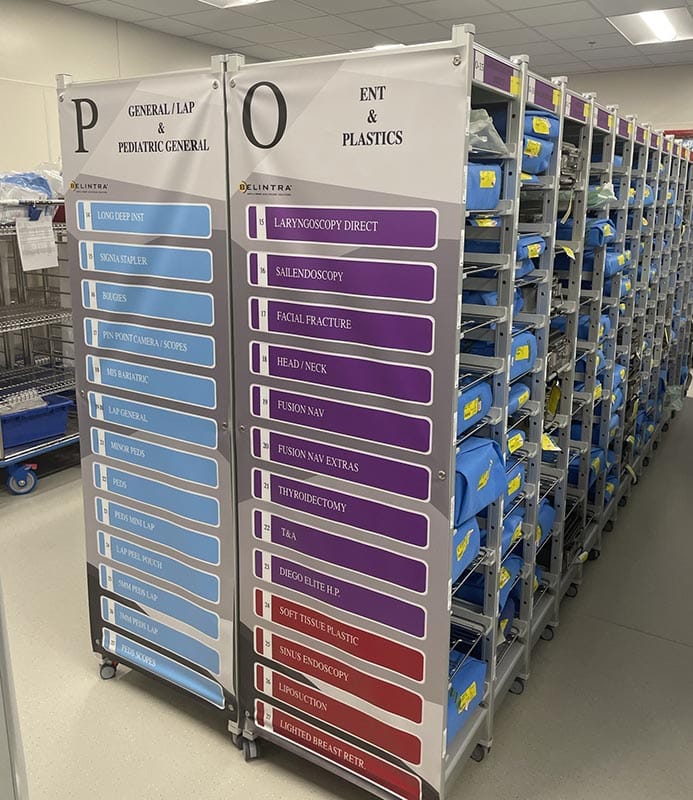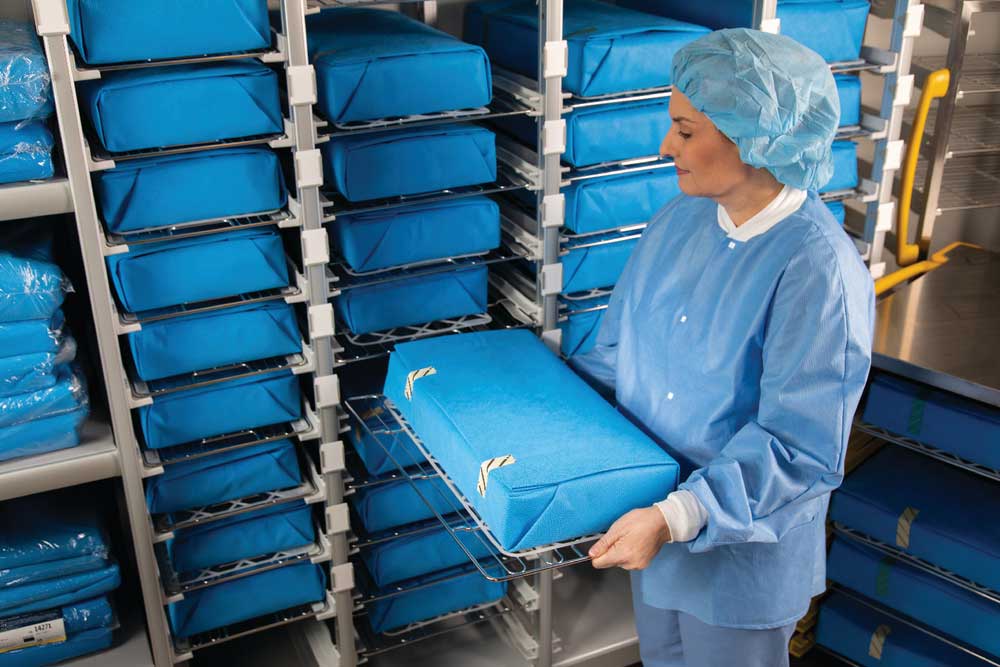Though often unseen, hospital sterile processing departments (SPDs) are considered the backbone of the operating room (OR). They help keep cases and scheduled procedures on track and make sure surgeons and nurses have the supplies and tools they need, when they need them. For leaders at high performing departments, like the team at Banner-University Medical Center Tucson (UMC Tucson) in Arizona, that organization, efficiency and a patient centered approach play a strategic role in keeping teams on track.
Lester Hubbard, senior manager of sterile processing at UMC Tucson, was faced with an interesting dilemma: how to effectively approach an increase in surgeries and the arrival of two new orthopedic surgeons that required 152 more tray spaces in the SPD. “Whenever you’re bringing in new surgeons or service lines, you need to adjust and prepare for how to manage the need for additional trays and build that into transition plans from the start,” said Timothy Brooks, Systems Program Director for Sterile Processing at Banner Health System. Knowing they needed a system to efficiently handle new work output, they turned to the HALYARD* and BELINTRA STERISYSTEM.® The storage and transport system is specifically designed to help SPDs increase storage space within their existing facility, reduce touchpoints and increase overall efficiency, leading to better outcomes for facilities, like UMC Tucson, and patients.
Before installing the HALYARD* and BELINTRA STERISYSTEM®, UMC Tucson had worked hard to maximize their storage space by standardizing their tray size but that wasn’t enough as the new surgeons meant additional trays in an already tight space. When you consider their footprint, you’d understand why. The full area of the ain core of the SPD is 6,000 sq. ft., which includes existing storage space. That’s only slightly larger than a regulation basketball court. “When we learned about the HALYARD* and BELINTRA STERISYSTEM®, we saw a potential solution to make the most of our current layout in an entirely new way, allowing us to do more with our existing space,” said Hubbard.
CUSTOMIZED SUPPORT EVERY STEP OF THE WAY
Hubbard and his team worked with O&M Halyard and BELINTRA to ensure a seamless process, starting with a no cost, on-site assessment of the SPD. The team measured the current SPD space and evaluated current operations, working to identify specific opportunities to maximize the use of space and improve the workflow. This included an in-person walk through to understand equipment in use, tray counts and procedures to determine ways to best use the allotted space and address staff challenges. When it came time to install the HALYARD* and BELINTRA STERISYSTEM® storage system, employees, rather than contractors, coordinated the logistics of the product shipment, assembled the system, organized the trays based on UMC Tucson feedback and best practices, and labeled the end caps for quick and easy identification for staff. The STERISYSTEM® team then spent time with the UMC Tucson employees to ensure they felt empowered with how to best use the system to maintain the efficiencies that were just created.
“Our STERISYSTEM® installation and transition process really is a key differentiator for us when it comes to bringing added value to our customers,” said Ken Brague, Clinical Product Specialist, Owens & Minor. “When I’m working with a customer, like UMC Tucson, I view it as a partnership, making sure they have all the knowledge and information they need to get the full facility-changing value of the HALYARD* and BELINTRA STERISYSTEM.®”
IMMEDIATE IMPACT
Once STERISYSTEM® was installed and employees trained on the system, teams felt the difference in efficiency and outcomes at UMC Tucson almost immediately. With the
STERISYSTEM® storage system, UMC Tucson gained additional room for close to 400 trays, meaning not only did they have room to accommodate the trays for the new surgeons, but they had room to support future storage needs in the SPD. Before the STERISYSTEM® installation, UMC Tucson was processing 700 trays a week, and saw outputs increase to close to 1,000 trays a week after installation, allowing the facility to increase procedures, better meet scheduled surgery demands and improve outcomes for the OR. Even the reps for consigned trays were pleased and gave feedback that it was easier to find their trays since everything had an assigned home.
“Our goal is to set our staff up for success, so they can do their job to the best of their ability with limited distractions,” said Hubbard. The HALYARD* and BELINTRA STERISYSTEM® helped us achieve this from the get-go, improving organization so staff can walk down the aisle, easily find and select what the need and get it to the OR, and therefore the patient, as efficiently as possible.”

MAXIMIZING FOR SPACE, SAFETY AND STAFF
HALYARD* and BELINTRA STERISYSTEM® improvements also stem from more than just improved organization and reduced touchpoints, but also by making the most of the space to further increase efficiency and safety outcomes. During the assessment and installation, the team was able to evaluate the UMC TUCSON space and identified oportunities to increase the storage ability of each column from eight trays per column to 11 trays on average, increasing tray storage and output, while decluttering central areas of the SPD workspace.
“Stacking is a big issue in a lot of the facilities I visit, as well as trays that don’t fit fully on shelves and hang out. Both of these pose safety hazards and slow down staff’s ability to quickly find and pull what they need,” said Brooks. “Once HALYARD* and BELINTRA STERISYSTEM® was installed, this changed greatly, with everything fitting on the shelves. It gave staff more room and eliminated the safety hazards of a cluttered space.”
While the HALYARD* and BELINTRA STERISYSTEM® installation was successful in improving UMC Tucson’s storage capabilities and tray outputs, it also helped to address some of the other critical shifts impacting hospital facilities and SPDs today, like staff burnout and morale. “STERISYSTEM® installation went beyond just Xs and Os and the numbers, but really brought together our staff to change the way teams work together,” said Hubbard. “After installation, members of the OR teams came down to the SPD to see the new layout. It was very rewarding to hear shared excitement about how the STERISYSTEM® installation, can help empower staff and improve cases.”
PATIENT-CENTERED CARE BEYOND THE BEDSIDE
Putting patients at the center of all they do rings true for teams across the Banner Health System, no matter their department. The HALYARD* and BELINTRA STERISYSTEM® allows facilities like UMC Tucson to identify opportunities for improvement and implement system changes, even if they have different layouts and concerns.
“Every improvement you can make matters, especially when working in a Level 1 trauma facility, like UMC Tucson,” said Brooks. “In these types of facilities, we can see volume increases anywhere from 10 to 20 percent. So any improvement we can make to be more organized efficient in the SPD goes a long way in approving patient care.”
At the end of the day, the SPD is really a key factor in the patient experience, and we view ourselves as patient advocates,” said Hubbard. “Many might not realize it, but our teams interact with patients too. The instruments we handle, wash, sterilize and assemble can directly impact them. That’s why everything we do is ultimately aimed at improving the patient experience and the STERISYSTEM® installation, helps us provide the highest quality of care. I am proud of the work we do at UMC Tucson and how the SPD contributes to improving our overall outcomes in creative and effective ways.”



